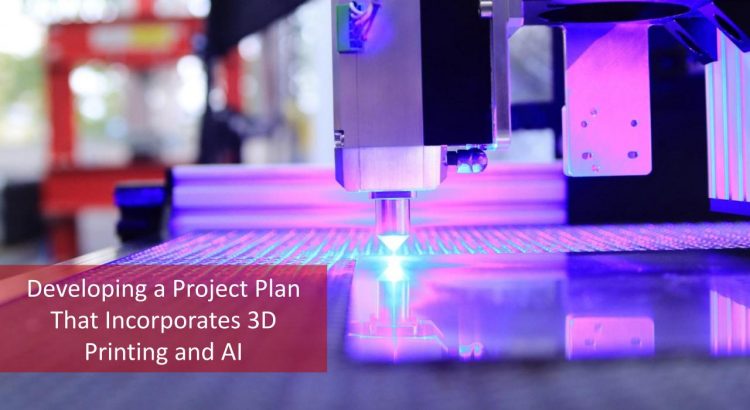In today’s world, technology isn’t just changing how we live—it’s reshaping how we work, build, and deliver value. As project managers, we’re often asked to turn bold ideas into practical realities. And few ideas feel bolder than combining 3D printing with artificial intelligence (AI).
On their own, these technologies are impressive. 3D printing lets us move from design to prototype in hours instead of weeks. AI, meanwhile, gives us the power to spot patterns, optimize decisions, and predict outcomes in ways humans simply can’t match at scale. But when you bring them together? That’s when real transformation happens. Imagine a design that’s improved by AI before it’s even printed, or a production schedule that automatically adapts to demand forecasts.
Of course, innovation doesn’t just happen on its own. Without a thoughtful project plan, even the most exciting technologies can fail to deliver. That’s why this article explores how to develop a clear, structured project plan for initiatives that merge 3D printing with AI—along with the business case to win executive support and drive measurable results.
Crafting Tailored Project Plans that Deliver Real Business Value (and How AI Can Help)
Why 3D Printing and AI Belong in the Same Project Plan
3D Printing: Manufacturing Without Limits
3D printing (additive manufacturing) empowers organizations to design and build products faster, cheaper, and with greater flexibility. Prototypes that once took weeks can be produced in hours, while custom designs can scale without massive upfront tooling costs.
AI: Data-Driven Precision and Optimization
Artificial Intelligence complements 3D printing by providing predictive analytics, quality control through computer vision, supply chain optimization, and automated decision-making. AI can forecast demand, monitor production, and even design better prototypes using generative algorithms.
The New Project Team: Humans and Bots (Autonomous AI Agents)
The Synergy
- AI analyzes and optimizes design → 3D printing brings it to life.
- AI predicts material usage and costs → 3D printing reduces waste.
- AI models demand trends → 3D printing meets just-in-time production.
Together, they create a closed-loop system that dramatically improves efficiency, reduces risk, and accelerates time-to-market.
The Business Case for 3D Printing + AI
Consider a mid-size manufacturing firm that produces medical devices. Traditional methods involve long design cycles, expensive tooling, and high material waste. By integrating 3D printing and AI into its operations, the firm can:
- Reduce prototyping costs by 70%.
- Shorten development cycles from 12 months to 4 months.
- Increase market responsiveness by using AI-driven demand forecasting.
- Cut material waste by 40% through AI-optimized designs and additive manufacturing.
The ROI is clear: reduced costs, faster delivery, higher customer satisfaction, and a stronger competitive position in a highly regulated, innovation-driven industry.
AI Agents: The New Superheroes for Project Managers
Detailed Project Plan: Integrating 3D Printing and AI
Here’s a step-by-step sample project plan for deploying a 3D printing and AI initiative:
1. Project Initiation
- Objective: Establish project goals—improve prototyping efficiency, reduce costs, increase responsiveness.
- Stakeholders: Executive leadership, R&D, operations, IT, suppliers, regulatory authorities.
- Deliverable: Business case approval and project charter.
2. Project Planning
- Scope Definition:
- Implement 3D printing for prototype and limited production runs.
- Deploy AI for demand forecasting, design optimization, and defect detection.
- Work Breakdown Structure (WBS):
- AI module development (forecasting, design analytics, quality assurance).
- 3D printing implementation (machine procurement, training, workflows).
- Integration layer (connecting AI insights with manufacturing processes).
- Timeline: 12 months with clear milestones.
- Budget: $2M with projected savings of $3.5M over 3 years.
- Risk Analysis: Regulatory compliance, supplier delays, AI algorithm bias.
Project Management Plan: The Key Project Management Tool and Deciding Factor of a Project’s Success
3. Execution
- Procure 3D printing equipment.
- Develop and test AI models.
- Train staff on new processes.
- Integrate systems and run pilot production.
4. Monitoring & Controlling
- Key Performance Indicators (KPIs):
- Cost reduction percentage.
- Prototype cycle time.
- Production error rates.
- Time-to-market improvements.
- Tools: AI-powered dashboards, project management software, automated reports.
5. Project Closure
- Final review of pilot outcomes.
- Document lessons learned.
- Scale the initiative across departments.
Project Closure Report Example – Wrapping Up Complex Projects
Skills Needed for Success
To lead a project at this level, project managers must combine traditional project management expertise with a solid grasp of emerging technologies. Skills required include:
- Project planning and risk management.
- Understanding of AI and data-driven decision-making.
- Knowledge of additive manufacturing workflows.
- Ability to align technology with strategic business goals.
This is where formal project management training becomes invaluable.
Final Thoughts
Projects that merge 3D printing and AI represent the future of innovation. A well-structured project plan not only ensures smooth execution but also builds a powerful business case that executives, investors, and stakeholders can rally behind.
By mastering project management skills, you can position yourself as the professional who confidently leads these transformative projects—whether in manufacturing, healthcare, aerospace, or beyond.
Project Management in the Age of AI: A Comparative Analysis of Jira, Asana, and Other Emerging Tools
Take the Next Step
If you’re serious about managing cutting-edge projects that leverage emerging technologies, it’s time to invest in your project management mastery.
👉 Join the PMP Live Class Virtual Training to gain the skills, frameworks, and confidence you need to lead complex, future-forward initiatives.
